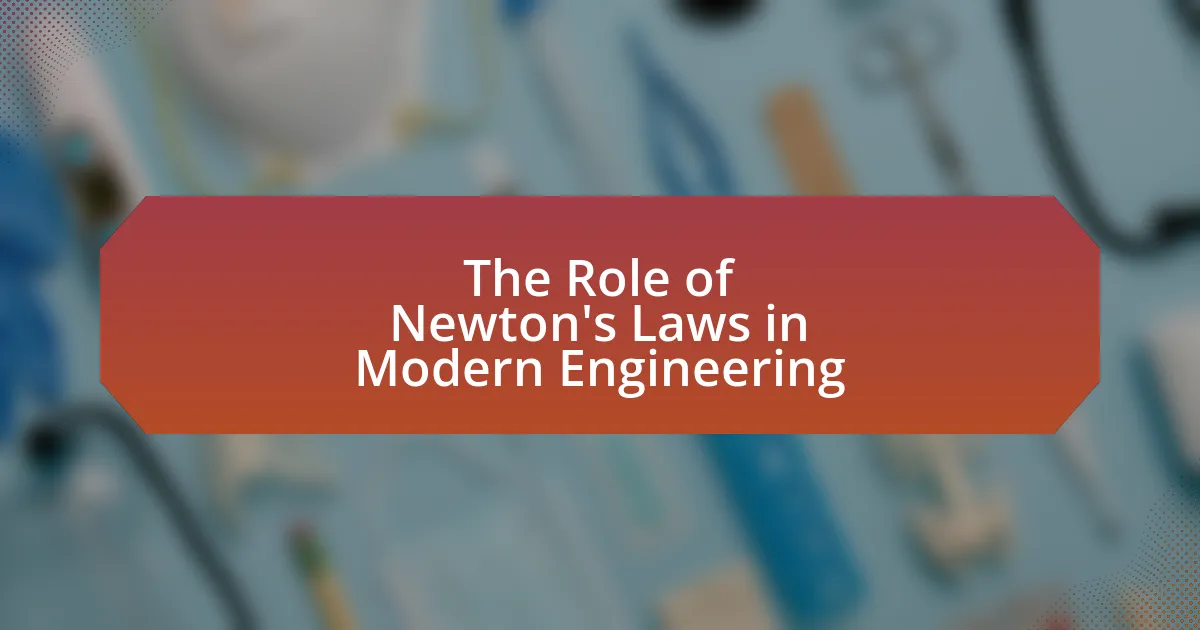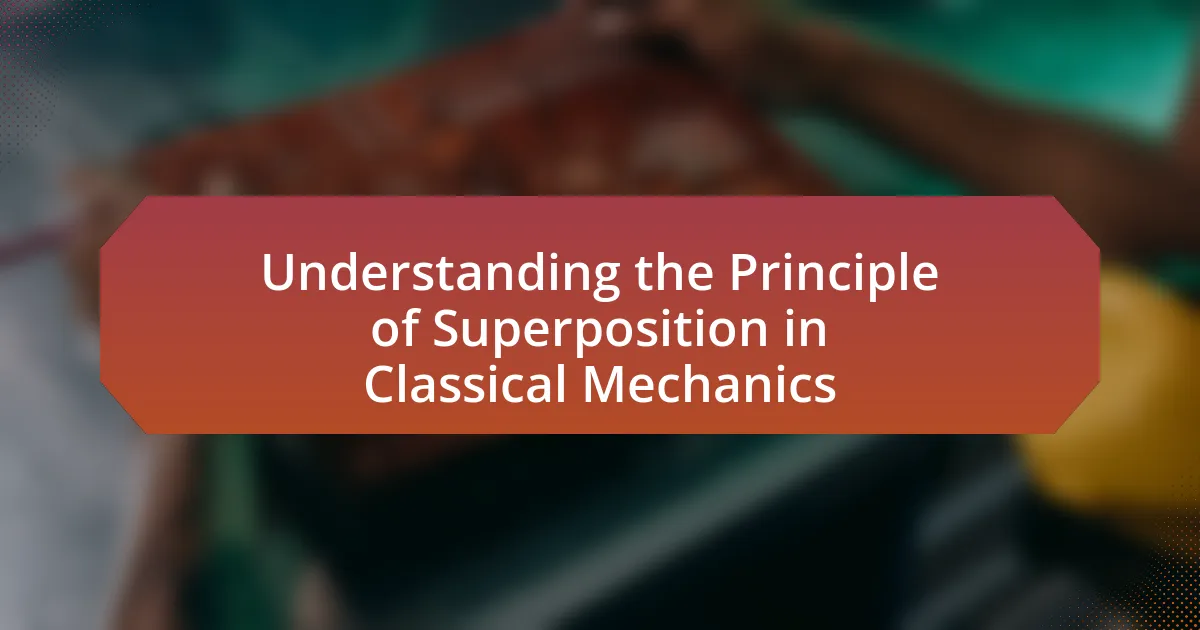Non-inertial frames are reference frames that are accelerating or rotating, leading to the presence of fictitious forces such as centrifugal and Coriolis forces. This article explores the significance of non-inertial frames in understanding motion and forces, highlighting their differences from inertial frames, the effects of acceleration on observers, and the implications for real-world applications in fields like physics, engineering, and navigation. Key concepts include the definition and characteristics of non-inertial frames, the impact of acceleration on measurements and perceptions of motion, and the methods used to analyze these frames, emphasizing the necessity of incorporating fictitious forces for accurate modeling and predictions.

What are Non-Inertial Frames and Their Importance?
Non-inertial frames are reference frames that are accelerating or rotating, meaning they do not adhere to Newton’s first law of motion, which states that an object in motion stays in motion unless acted upon by an external force. The importance of non-inertial frames lies in their ability to explain phenomena that cannot be accounted for in inertial frames, such as fictitious forces like centrifugal force and Coriolis force, which arise due to the acceleration of the frame itself. These concepts are crucial in fields such as physics and engineering, where understanding the effects of acceleration on observers is essential for accurate modeling and predictions in systems like rotating machinery or planetary motion.
How do Non-Inertial Frames differ from Inertial Frames?
Non-inertial frames differ from inertial frames primarily in that non-inertial frames are accelerating, while inertial frames are not. Inertial frames adhere to Newton’s first law, where an object remains at rest or in uniform motion unless acted upon by a force. Conversely, non-inertial frames experience fictitious forces, such as centrifugal force or Coriolis force, due to their acceleration. This distinction is crucial in physics, as it affects how observers measure motion and forces; for example, an observer in a non-inertial frame may perceive an object as being acted upon by an additional force that does not exist in an inertial frame.
What defines an Inertial Frame of Reference?
An inertial frame of reference is defined as a frame in which an object either remains at rest or moves at a constant velocity unless acted upon by an external force. This definition is grounded in Newton’s first law of motion, which states that an object will not change its state of motion unless a net force is applied. Inertial frames are characterized by the absence of acceleration; thus, observers within these frames will not experience fictitious forces, making them essential for understanding classical mechanics.
What are the characteristics of Non-Inertial Frames?
Non-inertial frames are characterized by the presence of fictitious forces acting on objects within them. These frames are accelerating or rotating relative to an inertial frame, leading to the perception of forces that do not arise from any physical interaction. For example, in a car that accelerates forward, passengers feel pushed back against their seats due to the inertial effects of acceleration. This phenomenon is explained by Newton’s laws of motion, which apply only in inertial frames. In non-inertial frames, observers must account for these fictitious forces, such as centrifugal force in a rotating frame or Coriolis force in a moving frame, to accurately describe motion.
Why is it essential to study Non-Inertial Frames?
Studying non-inertial frames is essential because they provide critical insights into the effects of acceleration on observers and the behavior of physical systems. Non-inertial frames, such as those undergoing rotation or linear acceleration, introduce fictitious forces, like centrifugal and Coriolis forces, which must be accounted for in accurate physical modeling. Understanding these concepts is vital in various applications, including engineering, navigation, and astrophysics, where precise calculations are necessary for safety and functionality. For instance, the Coriolis effect is crucial in meteorology for predicting weather patterns, demonstrating the practical importance of studying non-inertial frames.
What implications do Non-Inertial Frames have in physics?
Non-inertial frames have significant implications in physics, primarily affecting the perception of forces and motion. In these frames, observers experience fictitious forces, such as centrifugal and Coriolis forces, which arise due to the acceleration of the frame itself. For instance, when a car accelerates, passengers feel pushed back against their seats, illustrating how non-inertial frames alter the experience of motion. This phenomenon is crucial in understanding dynamics in rotating systems, where classical Newtonian mechanics must be adjusted to account for these additional forces. The necessity to introduce fictitious forces in non-inertial frames highlights the limitations of Newton’s laws when applied outside inertial contexts, thereby influencing the formulation of theories in classical mechanics and relativity.
How do Non-Inertial Frames affect real-world applications?
Non-inertial frames affect real-world applications by introducing apparent forces that influence the behavior of objects within those frames. For instance, in a rotating reference frame, such as a merry-go-round, observers experience centrifugal and Coriolis forces, which can alter the trajectory of moving objects. This phenomenon is critical in fields like aviation and space travel, where pilots and astronauts must account for these forces to ensure accurate navigation and control. Studies in physics demonstrate that neglecting these effects can lead to significant errors in calculations, impacting safety and performance in practical scenarios.

What Effects Does Acceleration Have on Observers in Non-Inertial Frames?
Acceleration causes observers in non-inertial frames to experience fictitious forces, such as centrifugal and Coriolis forces, which do not exist in inertial frames. These fictitious forces arise because the observers are in a frame that is accelerating relative to an inertial frame, leading to perceived effects that can alter their measurements and observations. For example, an observer in a rotating frame may feel pushed outward, despite no actual force acting on them, illustrating how acceleration distorts their perception of motion and forces. This phenomenon is well-documented in classical mechanics, particularly in the context of rotating reference frames, where the effects of acceleration are mathematically described by the equations of motion that include these fictitious forces.
How does acceleration influence the perception of motion?
Acceleration significantly influences the perception of motion by altering the observer’s frame of reference and the way they interpret changes in velocity. In non-inertial frames, such as those experiencing acceleration, observers may perceive objects as moving differently than they would in inertial frames due to the effects of fictitious forces. For example, when a vehicle accelerates, passengers may feel pushed back into their seats, which can distort their perception of the speed and direction of the vehicle’s motion relative to the environment. This phenomenon is supported by studies in physics and psychology, which demonstrate that acceleration can create a sense of motion that does not align with the actual movement of objects outside the accelerating frame.
What are fictitious forces, and how do they arise?
Fictitious forces are apparent forces that arise in non-inertial reference frames, where observers experience acceleration. These forces, such as centrifugal force and Coriolis force, do not result from any physical interaction but instead emerge due to the acceleration of the reference frame itself. For example, when a car accelerates, passengers feel pushed back against their seats; this sensation is attributed to fictitious forces acting on them in the accelerating frame. The concept is validated by Newton’s laws of motion, which apply strictly in inertial frames, indicating that fictitious forces are necessary to account for the observed effects in non-inertial frames.
How do observers in Non-Inertial Frames experience these forces?
Observers in non-inertial frames experience fictitious forces, such as centrifugal and Coriolis forces, due to the acceleration of their reference frame. These forces arise because the observers are in a frame that is accelerating relative to an inertial frame, leading to the perception of forces that do not exist in an inertial frame. For example, when a car accelerates, passengers feel pushed back into their seats, which is a result of the inertial effects experienced in the non-inertial frame of the car. This phenomenon is explained by Newton’s laws of motion, which state that an object in motion tends to stay in motion unless acted upon by an external force. In non-inertial frames, the apparent forces are necessary to account for the motion observed by the observers, thus validating their experience of these fictitious forces.
What are the consequences of acceleration on measurements?
Acceleration affects measurements by introducing apparent forces that can distort the perceived values of physical quantities. In non-inertial frames, such as those experiencing acceleration, observers may measure different values for mass, force, and time due to the influence of fictitious forces, like centrifugal and Coriolis forces. For example, an observer in a car accelerating forward will perceive a heavier object due to the inertial effects acting on it, which can lead to inaccuracies in measurements of weight and force. This phenomenon is supported by the principles of classical mechanics, particularly Newton’s laws, which indicate that the laws of motion apply differently in non-inertial frames compared to inertial frames.
How does acceleration affect time and space measurements?
Acceleration affects time and space measurements by causing time dilation and length contraction, as described by Einstein’s theory of relativity. In a non-inertial frame, such as one experiencing acceleration, time appears to pass more slowly relative to an observer in an inertial frame. This phenomenon is quantified by the Lorentz transformation equations, which show that as an object’s velocity approaches the speed of light, the time experienced by that object slows down compared to a stationary observer. Additionally, objects in motion experience length contraction, meaning that their measured length in the direction of motion decreases from the perspective of a stationary observer. These effects have been confirmed through experiments, such as those involving atomic clocks on fast-moving jets, which demonstrate measurable differences in elapsed time compared to stationary clocks.
What role does acceleration play in the relativity of simultaneity?
Acceleration plays a crucial role in the relativity of simultaneity by affecting the perception of time between observers in different frames of reference. In non-inertial frames, where acceleration is present, events that are simultaneous in one frame may not be simultaneous in another due to the influence of acceleration on the time experienced by observers. This phenomenon is illustrated by the fact that an observer accelerating in a vehicle will measure different time intervals for events occurring at different locations compared to an observer at rest. The implications of this are grounded in Einstein’s theory of relativity, which shows that simultaneity is not an absolute concept but rather depends on the relative motion and acceleration of observers.

How Can We Analyze and Apply Concepts of Non-Inertial Frames?
To analyze and apply concepts of non-inertial frames, one must understand that these frames are accelerating reference points where Newton’s laws of motion do not hold without modifications. In non-inertial frames, fictitious forces, such as centrifugal and Coriolis forces, must be introduced to account for the observed motion of objects. For example, when analyzing a rotating carousel, an observer on the carousel experiences an outward force, which can be explained by the centrifugal force acting on them due to the rotation. This understanding is crucial in fields such as physics and engineering, where accurate predictions of motion are necessary. The application of these concepts can be seen in technologies like GPS, where corrections for non-inertial effects are essential for precise location tracking.
What methods are used to study Non-Inertial Frames?
To study non-inertial frames, researchers primarily use mathematical modeling, simulations, and experimental setups. Mathematical modeling involves applying Newton’s laws with fictitious forces to account for acceleration effects, allowing for the analysis of motion from a non-inertial perspective. Simulations, often conducted using computational physics software, enable the visualization of dynamics in non-inertial frames, providing insights into complex interactions. Experimental setups, such as rotating platforms or accelerometers, allow for real-world observation of phenomena like centrifugal and Coriolis effects, validating theoretical predictions. These methods collectively enhance the understanding of how acceleration influences observers in non-inertial frames.
How do experiments illustrate the effects of Non-Inertial Frames?
Experiments illustrate the effects of non-inertial frames by demonstrating how observers experience fictitious forces due to acceleration. For instance, in a rotating reference frame, such as a carousel, an observer feels pushed outward, which is a result of the centrifugal force acting on them. This effect is quantitatively analyzed in experiments involving pendulums on rotating platforms, where the pendulum’s motion deviates from its expected path due to the rotation. Such deviations confirm the presence of fictitious forces, validating the concept of non-inertial frames. Additionally, experiments with accelerometers in vehicles show that when the vehicle accelerates, passengers feel a force pushing them back into their seats, further illustrating how acceleration affects perception in non-inertial frames.
What mathematical models are used to describe Non-Inertial Frames?
Mathematical models used to describe non-inertial frames include the concept of fictitious forces, such as the Coriolis force and centrifugal force, which arise due to the acceleration of the reference frame. In a non-inertial frame, Newton’s laws of motion are modified to account for these fictitious forces, allowing for the analysis of motion from the perspective of an accelerating observer. For example, in a rotating frame, the equations of motion can be expressed as F = ma + Ffictitious, where Ffictitious represents the additional forces acting on objects due to the frame’s acceleration. This approach is validated by the necessity of introducing these forces to maintain the consistency of physical laws in non-inertial frames, as demonstrated in classical mechanics and rotational dynamics.
What practical applications arise from understanding Non-Inertial Frames?
Understanding non-inertial frames has practical applications in various fields, including aerospace engineering, navigation systems, and virtual reality. In aerospace engineering, the design of aircraft and spacecraft requires accounting for the effects of acceleration and rotation on instruments and control systems, ensuring accurate performance under non-inertial conditions. Navigation systems, such as those used in ships and submarines, utilize non-inertial frame concepts to correct for the effects of motion on positioning data, enhancing accuracy in determining location. In virtual reality, understanding non-inertial frames allows developers to create more immersive experiences by accurately simulating the effects of acceleration and rotation on user perception. These applications demonstrate the importance of non-inertial frames in enhancing safety, accuracy, and user experience across multiple domains.
How can engineers utilize Non-Inertial Frame concepts in design?
Engineers can utilize Non-Inertial Frame concepts in design by accounting for the effects of acceleration on forces experienced by objects within those frames. For instance, when designing vehicles or spacecraft, engineers must consider how occupants experience apparent forces due to acceleration, which can affect safety and comfort. The design of systems like seatbelts and cushioning in vehicles incorporates these concepts to mitigate the impact of sudden changes in motion, ensuring that forces acting on passengers are minimized. This application is supported by principles of classical mechanics, where the effects of non-inertial frames, such as fictitious forces, are well-documented in physics literature.
What are common challenges faced when working with Non-Inertial Frames?
Common challenges faced when working with non-inertial frames include the introduction of fictitious forces, difficulty in applying Newton’s laws, and the complexity of analyzing motion. In non-inertial frames, observers experience apparent forces, such as centrifugal and Coriolis forces, which complicate the analysis of physical systems. Additionally, Newton’s laws, which are valid in inertial frames, require modifications in non-inertial frames, making calculations more complex. For example, in a rotating frame, the Coriolis effect alters the trajectory of moving objects, necessitating adjustments in predictions of motion. These challenges highlight the need for careful consideration when applying classical mechanics in non-inertial contexts.
What best practices should be followed when dealing with Non-Inertial Frames?
When dealing with non-inertial frames, it is essential to apply the principle of introducing fictitious forces to account for the effects of acceleration. This practice allows observers in non-inertial frames to analyze motion as if they were in an inertial frame. For example, when an observer is in a rotating frame, they must consider the centrifugal force acting outward and the Coriolis force affecting moving objects. These fictitious forces help in accurately predicting the behavior of objects within the non-inertial frame. Additionally, it is crucial to maintain consistency in the reference frame used for calculations, ensuring that all forces and accelerations are accounted for relative to that frame. This approach is validated by classical mechanics, which demonstrates that the laws of motion can be applied universally when fictitious forces are included.




